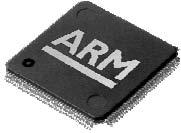ARM Teams With GlobalFoundries for 28nm
ARM, the big name in mobile chips, today announced a long-term strategic relationship with GlobalFoundries for processor implementation and circuit optimization.
The partnership will focus on an System-on-Chip enablement program that's built around ARM Physical IP, Fabric IP and Processor IP that will combine with GlobalFoundries’ most advanced High-K Metal Gate semiconductor manufacturing capabilities.
The effort between the two companies will first focus on the ARM Cortex-A9 using a 28nm HKMG process – a process that GlobalFoundries says is a 28nm “Gate First” HKMG technology that is optimized for high performance processing with minimal leakage. This makes it well-suited for mobile solutions such as handsets, smartphones, e-readers and MIDs.
“This announcement reflects our business value and strategy of providing best in class processor implementation by marrying our own processor and physical IP with world class manufacturing semiconductor technology,” said Warren East, chief executive officer, ARM. “This collaboration with GlobalFoundries and their commitment to delivering leading edge technology makes them an ideal partner to accelerate the adoption of ARM processor based technology at 28nm.”
The currently existing ARM Cortex-A8 is used in the Apple iPhone 3GS and Palm Pre.
Get Tom's Hardware's best news and in-depth reviews, straight to your inbox.
-
the_krasno 28nm? Now? I can't wait! I really hope AMD's next processor line will be 28nm instead of 32nm, that will be interesting!Reply -
coopchennick I wonder if AMD will use GlobalFoundries to produce their next chips. We know they are using TSMC for their Radeons.Reply -
vh1atomicpunk AMD SOCs! DX11 chips+CPU+IMC+Cache. It will be expensive, but overall platforms costs will drop. Express Intel to strike first or follow suit.Reply
Either way its good. -
jennyh It's everybody else vs intel now - that is what happens to corrupt organisations.Reply
The end of the evil empire is near. -
Area51 Date Please!!!!.... Just to say that you will go to 28nm dosn't have any value if its going to happen after 2013.... Will they have 28nm in the next 2 years, or are they just anouncing the relationhip but most likely have the product after intel in 2012?Reply
-
1ce I believe it's sometime in 2010. That's for LP (low power) Bulk Silicon, which means it applies to mobile processors like the ARM core, and i think it is for GPUs as well.Reply
Not to be confused with Silicon on Insulator (SOI) which is used for CPUs, Global Foundries won't have that ready until late 2010. -
WheelsOfConfusion CoopCHennickI wonder if AMD will use GlobalFoundries to produce their next chips. We know they are using TSMC for their Radeons.GlobalFoundries is AMD's former manufacturing arm, spun off when the company re-arranged itself in an effort to become profitable again. I'm pretty sure AMD will use any suitable process GF has available.Reply
Not sure that this, specifically, is a good process for desktop chips, though. Low leakage means lower overclocks, even if the feature size is smaller. Embedded chips have traditionally been optimized to reduce leakage while desktop chips have not, to allow for overclocking headroom. -
anamaniac Cool.Reply
Though Intel has made a handful of 22nm chips.
http://www.tomshardware.com/news/Intel-22nm-CPU-core-2011,8710.html
Just like Intel 22nm chips, these 28nm chips chips are still a while away.
Awesome regardless. -
jennyh 28nm will be for ATI gpu's as well as ARM chips.Reply
32nm will be for AMD's cpu's, the next one after that will be 22nm, due in 2011-2012. -
JonathanDeane One also has to consider that the companies are starting to measure nm's from different components on a CPU... just recently there was an article on here about angular density being greater on Intel's 32nm parts VS the competition at 28nm. I do not know exactly what angular density means but I am sure they mean they can pack more parts in a smaller area... when I google it my head explodes after the first few pages (its early in the morning for me so maybe later I will be able to digest that)Reply

